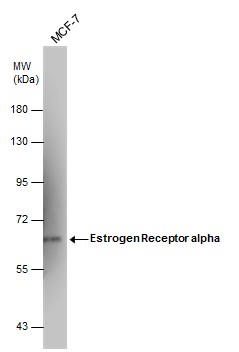Anti-Estrogen Receptorα Antibody (3335)
Anti-Estrogen Receptorα Antibody (3335)
Product No.: 3335
- -
- -
Clone 1F3 Target Estrogen Receptorα Formats AvailableView All Product Type Monoclonal Alternate Names ER, ER-α, Estradiol receptor, Nuclear receptor subfamily 3 group A member 1 Isotype Mouse IgG1 Applications FACS , IHC FF , IP , WB |
Data
 Whole cell extract (60 ug) was separated by 7.5% SDS-PAGE, and the membrane was blotted with Estrogen Receptor alpha antibody (3335) diluted at 1:500. The HRP-conjugated anti-mouse IgG antibody was used to detect the primary antibody, and the signal was developed with Trident femto Western HRP Substrate.
Whole cell extract (60 ug) was separated by 7.5% SDS-PAGE, and the membrane was blotted with Estrogen Receptor alpha antibody (3335) diluted at 1:500. The HRP-conjugated anti-mouse IgG antibody was used to detect the primary antibody, and the signal was developed with Trident femto Western HRP Substrate. - -
- -
Antibody DetailsProduct DetailsReactive Species Human Host Species Mouse Immunogen 6-His fusion protein containing the region encoding aa 1-190 of human estrogen receptor-a (ER-a) expressed in E. coli. Product Concentration 1.0 mg/ml Formulation PBS, pH 7.4, 1mg/ml. State of Matter Liquid Product Preparation Purified by Protein G affinity chromatography Storage and Handling This antibody is stable for at least one (1) year at -20°C. Avoid multiple freeze-thaw cycles. Regulatory Status Research Use Only Country of Origin USA Shipping Next Day 2-8°C Applications and Recommended Usage? Quality Tested by Leinco Immunoblotting: use at 1-5ug/mL.
Immunohistochemistry: frozen sections, use at 1-10ug/mL.FACS: use at 1-10ug/mL. Immunoprecipitation: use at 1-5ug/mL. Positive controls: MCF-7 cells and recombinant protein. These are recommended concentrations. Endusers should determine optimal concentrations for their applications. Each investigator should determine their own optimal working dilution for specific applications. See directions on lot specific datasheets, as information may periodically change. DescriptionSpecificity This antibody recognizes human and rabbit ER-alpha, a 65 kD protein and a member of the steroid family of nuclear receptors. ER-alpha is a ligand-activated transcription factor that, when bound to estrogen, induces a conformational change that allows dimerization and binding to estrogen response element sequences. When bound to DNA, ER-alpha can positively or negatively regulate gene transcription. Function Nuclear hormone receptor. The steroid hormones and their receptors are involved in the regulation of eukaryotic gene expression and affect cellular proliferation and differentiation in target tissues. Ligand-dependent nuclear transactivation involves either direct homodimer binding to a palindromic estrogen response element (ERE) sequence or association with other DNA-binding transcription factors, such as AP-1/c-Jun, c-Fos, ATF-2, Sp1 and Sp3, to mediate ERE-independent signaling. Ligand binding induces a conformational change allowing subsequent or combinatorial association with multiprotein coactivator complexes through LXXLL motifs of their respective components. Mutual transrepression occurs between the estrogen receptor (ER) and NF-kappa-B in a cell-type specific manner. Decreases NF-kappa-B DNA-binding activity and inhibits NF-kappa-B-mediated transcription from the IL6 promoter and displace RELA/p65 and associated coregulators from the promoter. Recruited to the NF-kappa-B response element of the CCL2 and IL8 promoters and can displace CREBBP. Present with NF-kappa-B components RELA/p65 and NFKB1/p50 on ERE sequences. Can also act synergistically with NF-kappa-B to activate transcription involving respective recruitment adjacent response elements; the function involves CREBBP. Can activate the transcriptional activity of TFF1. Also mediates membrane-initiated estrogen signaling involving various kinase cascades. Essential for MTA1-mediated transcriptional regulation of BRCA1 and BCAS3 (PubMed:17922032). {PubMed:10681512, PubMed:10816575, PubMed:11477071, PubMed:11682626, PubMed:14764652, PubMed:15078875, PubMed:15891768, PubMed:16043358, PubMed:16617102, PubMed:16684779, PubMed:17922032, PubMed:17932106, PubMed:18247370, PubMed:19350539, PubMed:20074560, PubMed:20705611, PubMed:21330404, PubMed:22083956, PubMed:7651415, PubMed:9328340}.; [Isoform 3]: Involved in activation of NOS3 and endothelial nitric oxide production (PubMed:21937726). Isoforms lacking one or several functional domains are thought to modulate transcriptional activity by competitive ligand or DNA binding and/or heterodimerization with the full-length receptor (PubMed:10970861). Binds to ERE and inhibits isoform 1 (PubMed:10970861). {PubMed:10970861, PubMed:21937726}. NCBI Gene Bank ID UniProt.org Research Area Cancer Research References & CitationsTechnical ProtocolsCertificate of Analysis |
Formats Available
- -
- -
Prod No. | Description |
|---|---|
3335 | |
56250 |


![Non-transfected (–) and transfected (+) 293T whole cell extracts (30 ug) were separated by 7.5% SDS-PAGE, and the membrane was blotted with Estrogen Receptor alpha antibody [1F3] (3335) diluted at 1:5000. The HRP-conjugated anti-mouse IgG antibody was used to detect the primary antibody.](https://www.leinco.com/wp-content/uploads/2025/01/qed-bioscience-anti-estrogen-receptor-alpha-antibody-3335-2.jpg)
![Various whole cell extracts (30 ug) were separated by 7.5% SDS-PAGE, and the membrane was blotted with Estrogen Receptor alpha antibody [1F3] (3335) diluted at 1:1000. The HRP-conjugated anti-mouse IgG antibody was used to detect the primary antibody.](https://www.leinco.com/wp-content/uploads/2025/01/qed-bioscience-anti-estrogen-receptor-alpha-antibody-3335-3.jpg)
